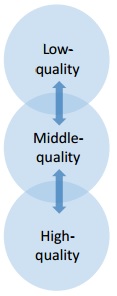Effective relationships between managers and employees are vital to the performance of a company. The quality of manager and employee relationships can impact organizational outcomes such as profits, customer service, job satisfaction, etc. A climate of good relationships between managers and employees can help recruit quality staff, and can keep employee turnover low. Having a good relationship with their supervisor is an important aspect of the job for employees. As a business evolves through stages, so does the manager-employee relationship. Research suggests that this relationship can be one of three types: low- medium-, and high-quality[1].
High-Quality (HQ) Relationship: A HQ relationship is characterized as having high degrees of trust, respect, admiration, and social exchange. HQ employees are the “go to person” or the “star employee”. They exhibit higher levels of performance, job satisfaction, dependability, and have low turnover. HQ relationships are high maintenance for managers since the relationships tend to be differentiated by high levels of mentoring, coaching, and socializing.
Middle-Quality (MQ) Relationships: These employees tend to be your “worker bees” or the “engine” of your organization. The organizational outcomes of the middle-quality group are similar to those of the HQ employees. For example, they perform just as well as HQ and have higher levels of job satisfaction, and lower levels of stress and role ambiguity. More importantly, these employees tend to be self-sufficient.
Low-Quality (LQ) Relationships: LQ employees tend to have higher turnover and are less productive. They experience higher levels of uncertainty about their roles and abilities, therefore requiring more managerial oversight. This requires a disproportionate amount of a manager’s time and resources to address these issues.
Earlier, researchers suggested that MQ & LQ relationships are less effective than HQ. But what some researchers and practitioners fail to realize is that some employees are satisfied with their relationships at levels below HQ and thus, can be productive at these levels. The most effective organizations will have no more than 10 – 20% of their employees in the HQ and LQ relationships, and 70 – 80% in the MQ. Both HQ and LQ relationships are time consuming and require considerable involvement on the part of the manager. Hence, managers cannot afford to develop HQ relationships with the majority of their employees or sustain too many LQ relationships. However, they can effectively and efficiently sustain MQ relationships with most of their staff.
Having knowledge and understanding of your employees’ relationship quality preferences can lead to productive and effective relationships. So the question is how do you build and maintain effective and productive relationships with employees who do not prefer a “star employee” status? There are three easy steps you can employ.
- Accept that not all employees aspire to have a high-quality relationship. While some employees desire power, status, responsibility, and money, others have other priorities, including family and life outside work. They work hard and want to do a good job, but are content not to be among the select HQ staff members.
- Determine the current quality of the relationship. Meet with your employee one-on-one every two weeks. In these meetings, determine whether your employee is happy with the quality of the relationship. If not and if possible, attempt to evolve the relationship to their preferred type.
- Reevaluate periodically the expectations of the employee and your ability to sustain that level of quality. Keep in mind that an employee’s aspirations, goals, and issues at work or home can change, therefore impacting the quality of the relationship.
Inadvertently, managers can overlook the value of the MQ group because their time and resources are consumed by the HQ & LQ groups. By developing MQ relationships with a majority of their employees, managers can ensure that they lead a productive team, but avoid being overwhelmed by maintaining and sustaining too many HQ and LQ relationships. Next month, we will go into more detail on how to conduct effective and productive one-on-one meetings with your employees.
If you would like to know more about the three different relationships types, please click on the following link to view a short, live presentation: http://www.uaa.alaska.edu/studentaffairs/ConversationCafe/seawolfhowls/work-relationships.cfm
Written by Dr. Terry A. Nelson, Assistant Professor of Leadership, College of Business and Public Policy, University of Alaska Anchorage and Dr. Bogdan Hoanca, Professor of Management Information Systems, Director of Graduate Programs, College of Business and Public Policy
Dr. Nelson joined the University of Alaska Anchorage in fall 2013 and is currently an Assistant Professor of Leadership where her research focuses on leadership, cross-cultural issues, diversity, and work stress and coping. Prior to joining UAA, she spent over seventeen years in leadership roles for two Fortune 500 companies (Kroger and Coca-Cola Enterprises) and a large regional bank (First Tennessee Bank). She teaches MBA leadership classes and is the Faculty Coordinator for the Leadership Fellows Program.
[1] Graen, G. & Uhl-Bien, M. 1995. Relationship-based approach to leadership: Development of leader-member exchange (LMX) theory of leadership over 25 years: Applying a multi-level multi-domain perspective. The Leadership Quarterly, 6(2): 219 – 247.


